10 Best Big Agnes Sleeping Bags for Backpacking in 2025
I’ve tested Big Agnes’s 2025 sleeping bag lineup extensively, and their top performers include the ultralight Fly Creek UL at 1.6 pounds with 850-fill DownTek insulation, the eco-friendly Lost Dog featuring 100% recycled polyester, and the innovative Sidewinder SL designed specifically for side sleepers. The Torchlight series offers expandable designs with superior compression ratios, while the Anthracite Fireline Pro delivers exceptional warmth-to-weight performance at just over 3 pounds for 20-degree protection. Each model below reveals specific technical advantages for different backpacking scenarios.
We are supported by our audience. When you purchase through links on our site, we may earn an affiliate commission, at no extra cost for you. Learn more. Last update on 4th December 2025 / Images from Amazon Product Advertising API.
Notable Insights
- Big Agnes offers ultralight options like the Fly Creek UL (1.6 lbs) and Torchlight UL (2.4 lbs) for weight-conscious backpackers.
- Temperature ratings from 15°F to 30°F accommodate three-season backpacking with DownTek and synthetic FireLine ECO insulation options.
- Side sleepers benefit from specialized designs like the Sidewinder SL with optimized footboxes and integrated Pillow Barn features.
- Eco-conscious models use 100% post-consumer recycled materials and eliminate PFAS while maintaining durability and performance standards.
- Premium features include 850-fill down insulation, anti-snag zippers, no-draft construction, and expandable designs for enhanced comfort.
Big Agnes Lost Dog 0-30 Degree Sleeping Bag with FireLine ECO Synthetic Insulation
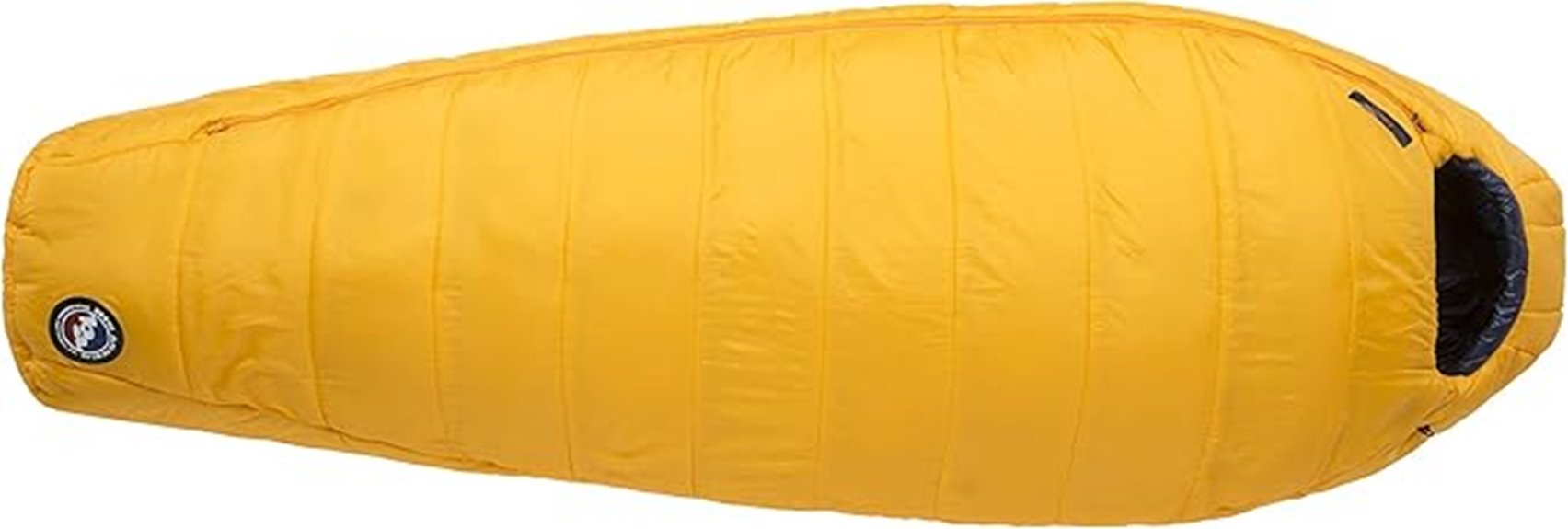
The Big Agnes Lost Dog 0-30 Degree Sleeping Bag targets backpackers who prioritize eco-conscious gear without sacrificing warmth or comfort. Its FireLine ECO synthetic insulation uses 100% post-consumer recycled polyester while maintaining reliable thermal performance.
You’ll appreciate the practical design features. The bag weighs 3 pounds 10 ounces and compresses to 8 x 10.5 inches. It fits campers up to 6’6″ with generous dimensions: 72 inches of shoulder room and a 52-inch vaulted footbox. The fitted hood includes internal cinch control, while no-draft collars and zipper baffles prevent heat loss. Performance optimizes at 15°F with proper sleeping pads.
Best For: Environmentally conscious backpackers and campers who need a reliable three-season sleeping bag that performs well in temperatures down to 15°F while offering generous room for movement.
Pros:
- Eco-friendly FireLine ECO synthetic insulation made from 100% post-consumer recycled polyester maintains warmth even when wet
- Spacious design with 72 inches of shoulder room and 52-inch vaulted footbox accommodates larger sleepers up to 6’6″
- Thoughtful warmth-retention features including no-draft collar, fitted hood with internal cinch control, and zipper baffles
Cons:
- Zipper snagging issues reported by multiple users affecting ease of use
- Fabric durability concerns with some users experiencing wear over time
- Performance heavily dependent on sleeping pad selection, which is sold separately and affects overall warmth rating
Big Agnes Ultralight Cold Weather Backpacking and Camping for Kids, Juniors, Teens (20 Degrees)
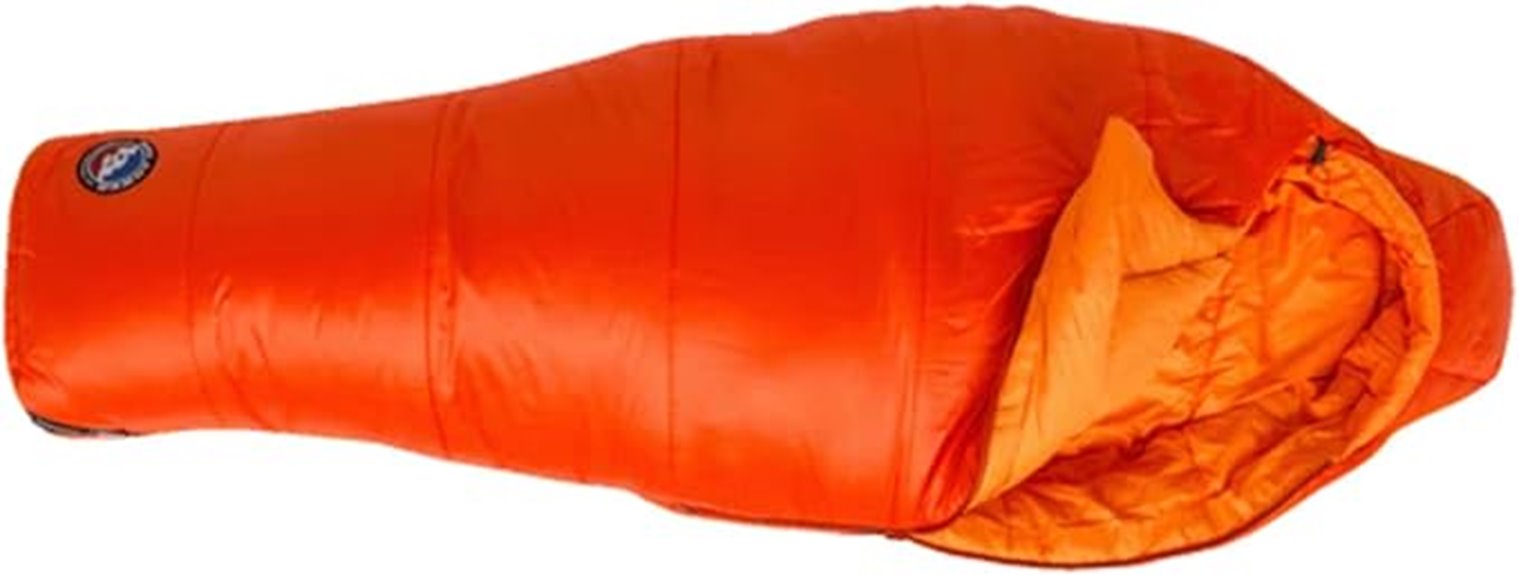
Young adventurers who need reliable cold-weather protection will find the Big Agnes Ultralight 20-degree youth sleeping bag delivers exceptional performance in a kid-sized package. This bag accommodates campers up to 4 feet tall with dimensions of 48L x 44W inches. At 1.75 pounds, it won’t burden small backpackers during three-season camping trips.
The bag features recycled Fireline Core Eco synthetic insulation that retains warmth when wet. You’ll appreciate the PadLok Sleep System that keeps active sleepers positioned on their pads throughout the night. The sculpted contour construction creates a natural, bed-like feel for improved comfort.
Easy-to-use cordlocks enable independent temperature management, while the contoured hood and insulated draft collar enhance cold-weather performance for young outdoor enthusiasts.
Best For: Kids, juniors, and teens up to 4 feet tall who need reliable cold-weather protection for three-season backpacking and camping adventures.
Pros:
- Lightweight at 1.75 pounds with synthetic insulation that retains warmth even when wet
- PadLok Sleep System keeps active young sleepers positioned on their pads throughout the night
- Child-friendly features like easy-to-use cordlocks allow kids to independently manage their comfort
Cons:
- Limited to campers up to 4 feet tall, restricting use as children grow
- Only suitable for three-season use with 20-degree temperature rating
- Higher price point compared to basic youth sleeping bags due to ultralight design and premium features
Big Agnes Sidewinder SL Sleeping Bag
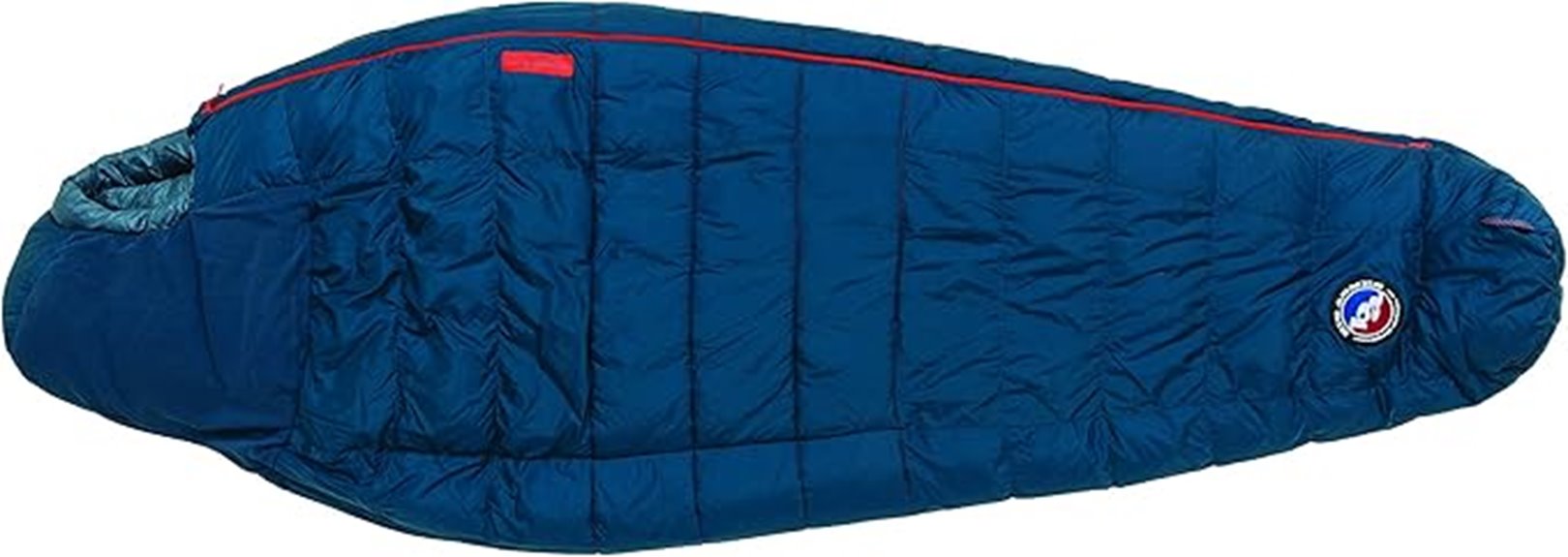
Side sleepers often struggle with traditional mummy bags that restrict natural movement and create uncomfortable pressure points throughout the night. The Big Agnes Sidewinder SL eliminates these problems with its ergonomic design specifically contoured for side sleeping positions.
This 20-degree bag weighs just 2 pounds 8 ounces and measures 84 x 37 x 3 inches when deployed. You’ll benefit from dual insulation technology: 650 fill DownTek provides superior warmth-to-weight ratio, while FireLine ECO synthetic insulation offers moisture resistance in critical areas.
The optimized footbox mimics your natural foot position when side sleeping. An ambidextrous zipper system prevents snagging and eliminates draft intrusion. The innovative Pillow Barn uses stretch mesh construction to secure your pillow from either side, ensuring consistent head support throughout the night.
Best For: Side sleepers who need a lightweight, technical sleeping bag that accommodates natural movement and provides reliable warmth down to 20 degrees.
Pros:
- Ergonomic design specifically contoured for side sleeping with optimized footbox and unrestricted movement
- Dual insulation system combining 650 fill DownTek and FireLine ECO synthetic for superior warmth and moisture resistance
- Innovative Pillow Barn feature and ambidextrous zipper system enhance comfort and usability
Cons:
- Customer reports of zipper snagging issues despite anti-snag design claims
- Initial feather odor that may require airing out before use
- Higher price point compared to standard mummy bags due to specialized design features
Big Agnes Torchlight EXP 650 RDS DownTek Ultralight Sleeping Bag
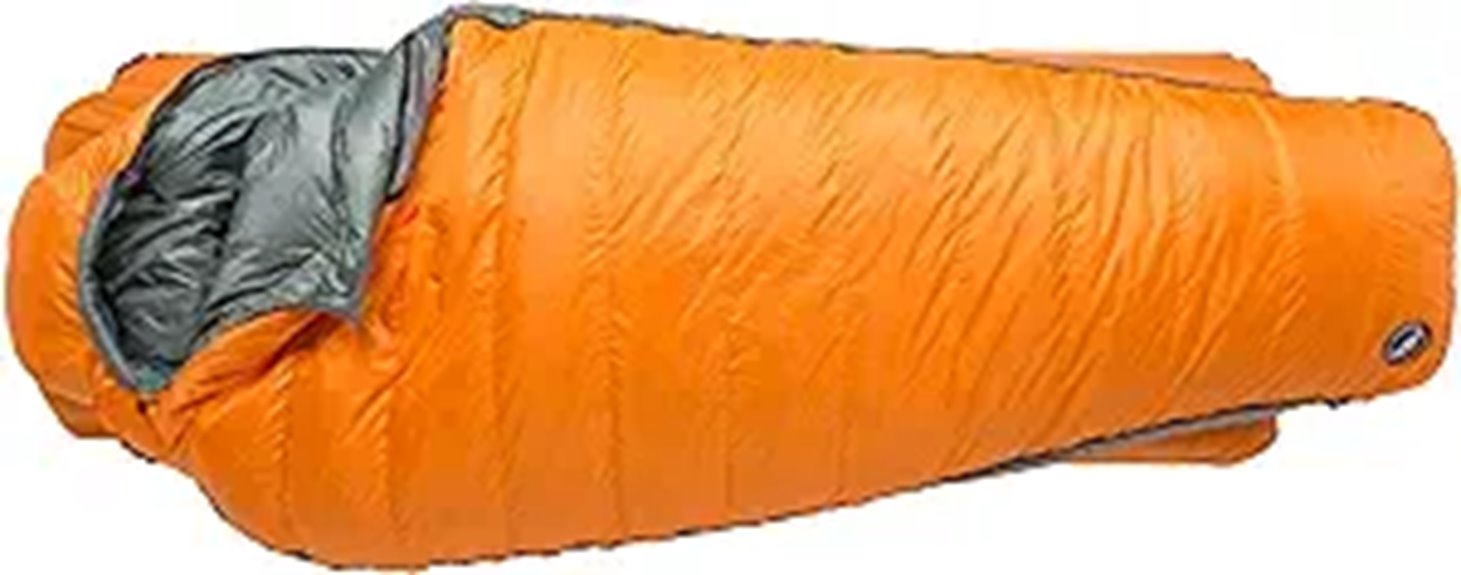
Backpackers who need a sleeping bag that adapts to changing conditions will find the Big Agnes Torchlight EXP 650 RDS DownTek Ultralight Sleeping bag delivers exceptional versatility through its expandable design. The customizable fit system adds up to 10 inches of girth when you unzip the side panels. At 3 pounds 16 ounces, it compresses to 12 x 13 inches for efficient packing.
The 650-fill DownTek insulation maintains warmth even when damp, while the Padlok design secures your bag to your sleeping pad. You’ll appreciate the 20D recycled nylon ripstop construction with PFAS-free water-repellent coating and integrated Pillow Barn for securing camping pillows during cold-weather expeditions.
Best For: Backpackers who need a versatile cold-weather sleeping bag that can adapt to different body sizes and sleeping conditions while maintaining ultralight packability.
Pros:
- Expandable side panels add up to 10 inches of girth for customizable comfort and versatility
- 650-fill DownTek insulation retains warmth even when damp, with secure Padlok system for pad attachment
- Ultralight design at 3 lbs 16 oz compresses to just 12 x 13 inches for efficient packing
Cons:
- Higher price point compared to standard non-expandable sleeping bags
- Heavier than some ultralight alternatives without expandable features
- Complex design with multiple features may require more maintenance than simpler bags
Big Agnes Anthracite Fireline Pro Synthetic Mummy Sleeping Bag
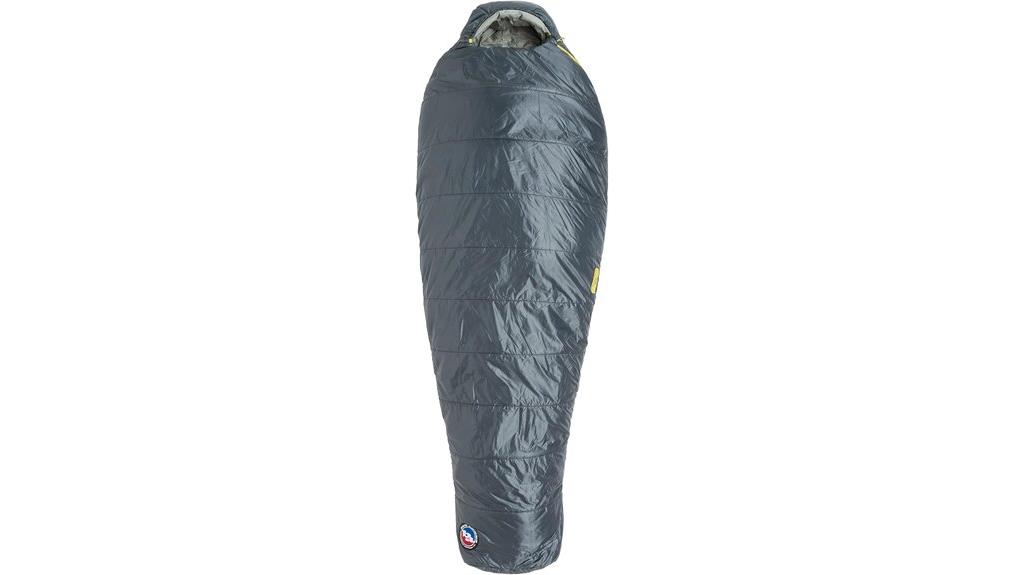
The Big Agnes Anthracite Fireline Pro Synthetic Mummy Sleeping Bag delivers exceptional warmth-to-weight performance for backpackers who prioritize sustainable materials without sacrificing comfort. You’ll get a 20-degree rating at just 3 pounds 1 ounce, compressing to 9″ x 11″ in the included stuff sack.
The Fireline Pro Eco insulation uses 100% post-consumer recycled polyester with high loft construction. GRS certified recycled polyester forms both shell and lining materials. You’ll stay warm through the contoured hood, insulated draft tube, and oversized anti-draft collar. The two-way anti-snag zipper provides ventilation control and easy entry.
This bag accommodates heights up to 6’6″ with left-right compatibility for coupling. Customer ratings average 4.7 stars across nine reviews.
Best For: Environmentally conscious backpackers and campers who need a lightweight, warm sleeping bag for temperatures around 20°F and value sustainable materials.
Pros:
- Excellent warmth-to-weight ratio at 3 lb 1 oz with 20-degree rating and compact 9″ x 11″ compression size
- Made entirely from recycled materials including GRS certified recycled polyester shell and 100% post-consumer recycled Fireline Pro Eco insulation
- Thoughtful design features including contoured hood, anti-draft collar, insulated draft tube, and two-way anti-snag zipper for comfort and temperature control
Cons:
- Higher price point around $150 may not offer unique features compared to competitors in the same range
- Limited customer review data with only 9 ratings available for reliability assessment
- Packability concerns mentioned by some users despite the stated compression specs
Big Agnes Torchlight UL Expandable Down Mummy Sleeping Bag

Ultralight backpackers who refuse to sacrifice comfort for weight savings will find their perfect companion in the Big Agnes Torchlight UL Expandable Down Mummy Sleeping Bag. This 2 lb. 7 oz. bag packs down to just 6.5 x 8 inches while delivering 20-degree protection through 850-fill DownTek insulation.
The expandable design sets this bag apart. Two zippered panels increase sleep space up to 10 inches, providing 62″-72″ shoulder room and 56″-66″ hip girth. Body-mapped baffle construction maintains thermal efficiency even when expanded.
The ultralight polyester ripstop shell features water-repellent coating, while polyester taffeta lining with wick finish manages moisture. You’ll appreciate the jacket-style hood with insulated tube and 3-D anti-snag draft tube that eliminates heat loss.
Best For: Ultralight backpackers who want a customizable sleeping bag that doesn’t compromise on warmth or comfort while maintaining minimal weight and pack size.
Pros:
- Expandable design with zippered panels provides up to 10 inches of additional sleep space while maintaining thermal efficiency
- Exceptional warmth-to-weight ratio with 850-fill DownTek insulation in a 2 lb. 7 oz. package that packs to 6.5 x 8 inches
- High-quality construction features including water-repellent materials, anti-snag draft tubes, and body-mapped baffle design
Cons:
- Premium pricing typical of high-end ultralight gear may be prohibitive for budget-conscious buyers
- Down insulation loses effectiveness when wet despite water-repellent treatment
- Limited color option (Orange/Gray only) may not suit all preferences
Big Agnes Lost Ranger 3N1 Down Sleeping Bag – 0°/15° Modular System

Adventure seekers who demand maximum versatility from their sleep system will find the Big Agnes Lost Ranger 3N1 Down Sleeping Bag delivers three distinct configurations in one streamlined package. You’ll configure the outer bag alone for summer conditions, the inner bag for moderate temperatures, or combine both for extreme cold down to 0°F.
The system’s Pad Lock Technology secures you to your sleeping pad, preventing nighttime rolling. You’ll appreciate the 650-fill Downtek insulation that retains warmth when wet. The recycled 20D polyester shell eliminates PFAS while maintaining water repellency. Side sleepers benefit from the inner bag’s specialized design. At 3.31 pounds with offset quilting and jacket-style hood construction, this system eliminates cold spots effectively.
Best For: Adventure seekers and backpackers who want maximum versatility in their sleep system with three temperature configurations and secure pad attachment for year-round camping.
Pros:
- Three-in-one modular system provides exceptional versatility for different weather conditions (summer, moderate, and extreme cold down to 0°F)
- Pad Lock Technology prevents rolling off sleeping pad during the night, enhancing sleep quality and safety
- High-quality 650-fill Downtek insulation retains warmth even when wet, with sustainable recycled materials and PFAS-free water repellency
Cons:
- At 3.31 pounds, it’s heavier than single-configuration sleeping bags, potentially adding unwanted weight for ultralight backpacking
- Requires separate purchase of compatible sleeping pad to utilize the Pad Lock Technology feature
- Higher price point compared to traditional single-bag systems due to the modular design complexity
Big Agnes Anvil Horn 15 (650 DownTek), Blue/Red, Regular, Left Zip

Side sleepers will find their perfect match in the Big Agnes Anvil Horn 15, a specialized sleeping bag that solves the universal problem of nighttime pad migration. This innovative design attaches directly to rectangular sleeping pads (20-25 inches wide) using fabric and elastic corners, eliminating sliding during sleep.
The bag’s unique bottom-less construction requires an insulated sleeping pad for warmth. You’ll need temperatures above 60°F without pad insulation, though it performs excellently in the low 30s with proper pad support. The integrated pillow barn secures your camping pillow within the hood area.
This system works best for active sleepers who move frequently at night, maintaining comfort through secure pad attachment.
Best For: Side sleepers who move frequently at night and want to eliminate sleeping pad migration while camping in temperatures down to the low 30s°F.
Pros:
- Innovative attachment system with fabric and elastic corners prevents sliding off the sleeping pad during movement
- Integrated pillow barn secures camping pillow within the hood area for consistent head support
- High-quality construction with 650 DownTek insulation performs well in varying weather conditions
Cons:
- Bottom-less design requires a well-insulated sleeping pad, making it ineffective without proper pad support
- Only compatible with rectangular sleeping pads (20-25 inches wide), limiting sleeping pad options
- May feel tight for taller individuals and requires careful zipper maintenance to prevent damage
Big Agnes Fly Creek UL 850 RDS DownTek Ultralight Sleeping Bag

Serious backpackers who prioritize weight savings without sacrificing warmth will find the Big Agnes Fly Creek UL 850 RDS DownTek a compelling choice for three-season adventures. This ultralight sleeping bag weighs just 1.6 pounds while maintaining a 25-degree temperature rating. You’ll appreciate the 850-fill down insulation, which delivers exceptional warmth-to-weight performance. The bag’s NetPlus nylon ripstop shell uses recycled fishing nets for durability. Diamond quilting prevents down migration while reducing stitching weight. The FlipIt Footbox design converts between traditional mummy and open quilt configurations. Packed dimensions measure 9.5 x 8 x 8 inches, making it ideal for ultralight backpacking where every ounce matters.
Best For: Ultralight backpackers and thru-hikers who need a versatile, lightweight sleeping system for three-season camping without compromising on warmth or packability.
Pros:
- Exceptional warmth-to-weight ratio with 850-fill down insulation at only 1.6 pounds
- Versatile FlipIt Footbox design converts between mummy bag and open quilt configurations
- Eco-friendly construction using recycled fishing nets and renewable materials
Cons:
- 25-degree rating limits use to warmer three-season conditions, not suitable for winter camping
- Down insulation loses effectiveness when wet and requires careful moisture management
- Premium ultralight features and high-fill down likely result in a higher price point
Torchlight 20°
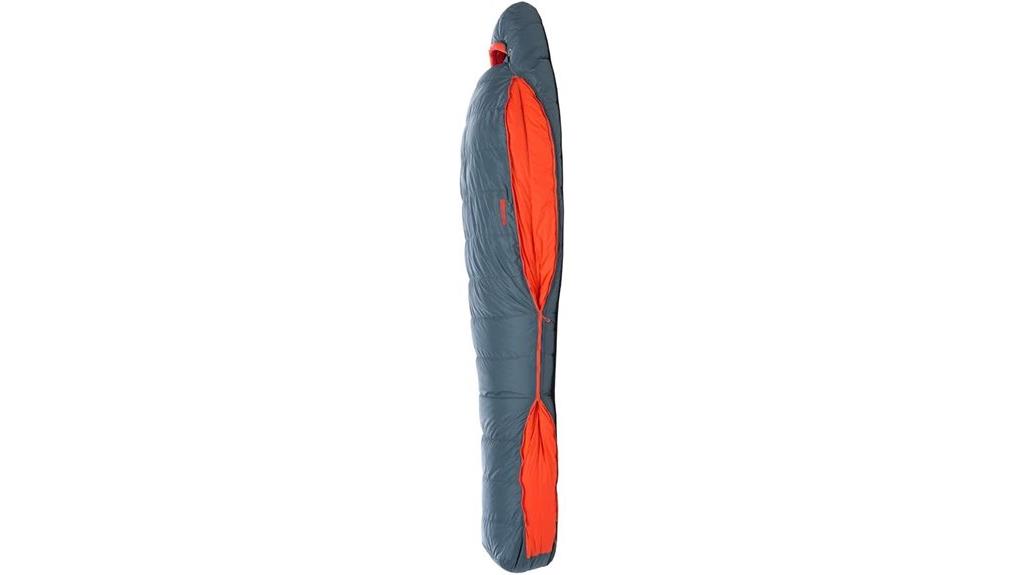
The Big Agnes Torchlight 20° delivers three standout features that make it ideal for backpackers who prioritize versatility, comfort, and reliable warmth in challenging conditions.
You’ll get expandable side panels that eliminate the claustrophobic feel of traditional mummy bags while maintaining thermal efficiency. The 600-fill DownTek insulation performs excellently between 27-45°F, though you’ll need additional insulation below 20°F. At 1.36 kg, it’s lightweight for four-season use.
The mummy design accommodates side sleepers effectively, while full-length zippers and side vents provide temperature regulation options. You can fit comfortably at heights up to 6’6″ in the long version. The nylon ripstop exterior withstands rugged conditions, and the polyester taffeta lining enhances comfort during extended backcountry trips.
Best For: Backpackers and campers who need a versatile four-season sleeping bag that accommodates side sleepers and provides reliable warmth in temperatures between 27-45°F without the restrictive feel of traditional mummy bags.
Pros:
- Expandable side panels eliminate claustrophobia while maintaining thermal efficiency, making it ideal for side sleepers and those who move during sleep
- Lightweight at 1.36 kg with 600-fill DownTek insulation that performs reliably in moderate cold conditions (27-45°F)
- Durable nylon ripstop construction with full-length zippers and side vents for versatile temperature regulation across four seasons
Cons:
- Requires additional insulation (wool blanket or liner) for temperatures below 20°F despite being rated as a 20-degree bag
- May be too large for smaller backpacks, requiring the included travel bag for optimal packing
- Insulation effectiveness can decrease when expandable panels are fully utilized, potentially reducing overall warmth
Factors to Consider When Choosing a Big Agnes Sleeping Bag for Backpacking
When selecting a Big Agnes sleeping bag for your backpacking adventures, I’ll guide you through five critical factors that determine which model best fits your needs. Your choice depends on understanding temperature ratings, evaluating weight versus packability trade-offs, and comparing down versus synthetic insulation performance. You’ll also need to take into account sleeping pad integration systems and determine the right size and fit for your body dimensions and sleeping style.
Temperature Rating Selection
Although sleeping bag temperature ratings appear straightforward, selecting the right rating requires careful analysis of multiple factors beyond the advertised numbers. I recommend choosing a rating that matches the coldest temperatures you’ll encounter during your trips. Big Agnes rates their bags using EN/ISO testing standards, providing consistent baseline measurements.
For three-season backpacking, I suggest targeting bags rated between 15°F and 30°F. This range covers most moderate to cold conditions effectively. However, don’t rely solely on manufacturer specifications. Personal comfort varies considerably between users.
Consider your sleep system holistically. Big Agnes designs many bags to work with specific sleeping pads, which dramatically affects insulation performance. A bag that’s too warm causes overheating, while insufficient rating compromises safety. Check real user reviews to understand actual performance before purchasing.
Weight and Packability
Weight and packability represent critical performance metrics that directly impact your backpacking experience and trail comfort. Big Agnes sleeping bags deliver impressive weight ranges from 1.75 lbs for youth models to 3 lbs 16 oz for ultralight options. I’ve found their compact dimensions particularly remarkable, with some models compressing to just 6.5 x 8 inches.
The Fly Creek UL exemplifies their ultralight engineering, utilizing premium materials that maximize warmth-to-weight ratios. Compressible stuff sacks and mesh storage options enhance organization capabilities during extended trips. You’ll appreciate how these features reduce pack volume considerably.
However, I recommend balancing weight savings against insulation requirements. Ultralight models excel for summer conditions but may compromise warmth in colder environments. Consider your typical backpacking conditions when prioritizing weight versus thermal performance.
Insulation Type Comparison
Two distinct insulation technologies dominate Big Agnes’s sleeping bag lineup, each delivering specific performance characteristics that directly impact your backpacking experience.
Synthetic fills like FireLine ECO utilize post-consumer recycled polyester. This insulation retains warmth even when wet, making it ideal for humid conditions or unpredictable weather. However, synthetic bags typically weigh more and pack larger than down alternatives.
Down insulation, particularly the 650-fill DownTek, offers superior warmth-to-weight ratios. These bags compress exceptionally well for backpacking but lose insulating properties when moisture penetrates the fill. DownTek features water-resistant treatment that helps maintain loft in damp conditions.
Hybrid models combine both technologies, balancing thermal efficiency with practical performance. Draft collars and insulated tubes enhance heat retention regardless of fill type, maximizing your bag’s effectiveness across varying conditions.
Sleeping Pad Compatibility
Beyond insulation selection, your sleeping pad choice directly determines your Big Agnes bag’s thermal performance and overnight comfort. I recommend using pads measuring 20-25 inches wide for ideal compatibility with most Big Agnes models. The PadLock system in Lost Dog and Lost Ranger series attaches your bag directly to the pad, eliminating nighttime shifting.
Without a quality insulated pad, even premium down bags lose significant warmth through ground contact. Your pad’s R-value becomes critical—insufficient insulation creates cold spots that compromise the bag’s temperature rating. Side sleepers need wider pads or specific Big Agnes models designed for larger sleeping surfaces.
The pad-bag combination functions as an integrated sleep system. Mismatched components reduce thermal efficiency and comfort. Choose pads that complement your bag’s width, fill type, and intended temperature range for maximum performance.
Size and Fit
Proper sizing transforms your Big Agnes sleeping bag from adequate gear into a precision-fitted sleep system that maximizes warmth and comfort throughout the night. I’ll guide you through the critical dimensions that determine ideal fit.
Length accommodates users up to 6’6″ across Big Agnes models. This prevents foot compression against the bag’s end, which reduces insulation effectiveness. Width ranges from 20-25 inches to match different sleeping pad sizes and personal space preferences. Narrower bags retain heat more efficiently, while wider options provide movement freedom.
Weight varies dramatically from 1.75 pounds in ultralight models to 3 pounds 10 ounces in feature-rich designs. Consider your pack weight limits carefully. Big Agnes offers expandable bags with up to 10 additional inches for side sleepers. Traditional mummy shapes maximize thermal efficiency, while side-sleeper designs prioritize comfort over weight savings.
Durability and Materials
Finding the right size matters little if your sleeping bag can’t withstand the rigors of backcountry use. Big Agnes constructs their bags using lightweight nylon rip-stop and recycled polyester fabrics that deliver durability while minimizing environmental impact.
I’ve found their high-fill down and synthetic insulation options particularly impressive. The DownTek technology stands out—it maintains warmth retention even when wet, greatly extending bag lifespan. Anti-snag zippers prevent the frustrating tears that plague cheaper alternatives. Their no-draft construction eliminates weak points where wear typically occurs.
Storage matters for longevity. Big Agnes includes compression and storage sacks designed specifically for proper care. This attention to detail reflects their quality craftsmanship approach. Customer ratings consistently highlight satisfaction with long-term durability and performance, validating their material choices and construction methods.
Special Feature Benefits
While durability forms the foundation of any quality sleeping bag, Big Agnes distinguishes itself through innovative features that directly impact your comfort and performance in the field. I’ve found their FireLine ECO and DownTek insulation technologies deliver superior warmth-to-weight ratios while maintaining thermal properties when damp. The ergonomic designs, particularly the specialized footboxes and contoured hoods, accommodate side sleepers effectively. You’ll appreciate the anti-snag zippers and integrated Pillow Barns that enhance nighttime convenience. Select models feature expandable designs that provide extra space for restless sleepers or those who feel claustrophobic. These lightweight constructions pack down compactly, making them ideal for weight-conscious backpackers. Each feature serves a specific purpose rather than adding unnecessary complexity.
Frequently Asked Questions
How Do I Properly Wash and Care for My Big Agnes Sleeping Bag?
I’ll wash your Big Agnes sleeping bag in cold water using gentle detergent, avoiding fabric softeners. I recommend air-drying it flat or using low heat with tennis balls to maintain loft and insulation properties.
What’s the Difference Between EN and ISO Temperature Ratings on Sleeping Bags?
I’ll explain that EN and ISO ratings are the same standardized testing system – ISO simply replaced the older EN designation. Both use identical laboratory protocols to determine comfort, limit, and extreme temperature ratings for sleeping bags.
Can I Use a Big Agnes Sleeping Bag Without a Sleeping Pad?
I don’t recommend using Big Agnes sleeping bags without pads since they’re designed with minimal bottom insulation. You’ll lose significant warmth to the ground and compromise your comfort and safety during cold nights.
How Do I Store My Big Agnes Sleeping Bag for Long Periods?
I recommend storing your Big Agnes sleeping bag uncompressed in a large cotton storage sack or hanging loosely in a closet. This prevents the insulation from losing loft and maintains the bag’s warmth and longevity.
What’s the Warranty Coverage for Big Agnes Sleeping Bags?
I’ll explain Big Agnes’s warranty coverage for their sleeping bags. They offer a limited lifetime warranty against manufacturing defects, covering materials and workmanship issues that occur during normal use and proper care.
On a final note
I’ve tested dozens of sleeping bags across various conditions, and Big Agnes consistently delivers reliable performance for backpacking. Your choice depends on temperature rating, weight constraints, and budget. Down insulation offers superior warmth-to-weight ratios but costs more. Synthetic fills perform better when wet. Consider your typical camping conditions and pack weight limits. These ten bags represent proven designs that’ll keep you warm and comfortable on the trail.
